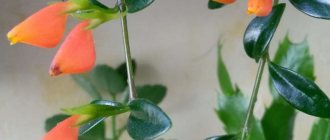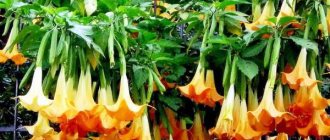Botanical description
The genus Laurel (lat. Laurus) is part of the Laurel family and has only 2 species. Grows in the Canary Islands and the Mediterranean region. Up to forty species of laurel are currently included in today's taxonomy in English. Laurels are evergreen shrubs or trees. The simple leaves are leathery to the touch, the edge of the leaf is entire and slightly wavy. The axillary inflorescences are umbrella-shaped. If the plant is well cared for, then young specimens can grow at high temperatures and low air humidity; adult specimens will grow poorly under such conditions.
Subtleties of crown formation
When grown indoors, the Laurel is shaped to achieve aesthetics. The procedure is performed in early spring. Complex cutting, creating the shape of a ball or cone, is done once. Subsequently, you will only need to maintain the achieved state. The plant tolerates the procedure calmly, the desired shape is broken slowly.
Briefly about cultivation
- Flowering: the plant is grown as an ornamental foliage plant.
- Lighting: bright sunlight.
- Temperature: in spring and summer – 20-26 ºC, in autumn the temperature is gradually reduced to 12-15 ºC.
- Watering: during the growing season - regular and plentiful, as soon as the top layer of the substrate dries. In hot weather, water twice a day. With the onset of autumn, watering is reduced, and in winter they simply make sure that the substrate does not dry out completely.
- Humidity: high: in hot weather, the plant should be sprayed regularly and kept on a tray with damp expanded clay.
- Feeding: during the growing season - once a month with complex mineral fertilizer. In winter, laurel is not fed.
- Dormant period: from October to March.
- Transplantation: young plants - once every two years, adults - once every 3-4 years.
- Substrate: two parts of humus soil, two parts of leaf soil and one part each of peat, turf soil and sand.
- Pruning: Pruning is carried out in mid-August.
- Reproduction: seeds, cuttings.
- Pests: scale insects, spider mites, mealybugs.
- Diseases: sooty fungus.
- Properties: the plant is a popular spice and has medicinal properties.
Read more about growing laurel below.
Homeland of the plant
The laurel's homeland is the countries of the Mediterranean Sea and Asia Minor. Since Antiquity, the shrub has been grown in areas with hot, dry summers and wet winters. It was these green branches that were given to winners, emperors, and athletes in ancient Rome and Greece.
In the Middle Ages, laurel was a symbol of goodness and protected from lightning and evil forces. Today, laurel is found in Italy, Turkey, Greece, Guatemala, Portugal, France, Georgia, the countries of the former Yugoslavia, and southern Russia. Laurel is grown as a spice and for decorative purposes in the Caucasus and Crimea.
It is often found in resort towns in southern Russia as a shrub-hedge along sidewalks and roads.
Important! Indoor laurel does not tolerate excessive dry air. Because of this, pests may develop on it.
This is a relict plant that has come down to us since the Tertiary period. In natural conditions, laurel can live for 3-4 centuries.
Care for laurel at home
Lighting
At home, the laurel plant easily tolerates direct sunlight, so it feels good in southern windows with bright lighting. In summer, it is best to take the laurel out into the fresh air. Despite the fact that laurel normally tolerates direct sunlight, after wintering or immediately after purchasing the plant, it is gradually accustomed to the sun to prevent sunburn. In winter, the plant is kept in a cool and bright place.
Temperature
The optimal temperature in summer is 20-26 °C. Starting in autumn, the temperature should be gradually reduced, and in winter, in order for wintering to be as painless as possible, the temperature should be within 12-15 °C.
Watering the laurel
In summer, home laurel should be watered generously with soft water as soon as the top layer of soil dries. You can water it a couple of times a day if the temperature is very high. In the fall, watering is reduced, and in winter it is watered only 2-3 days after the top layer of soil has dried.
- What does vriesia look like (photo)
Spraying
The laurel plant requires high air humidity - it must be constantly sprayed with settled water. It would be a good idea to place the pot with the plant on a tray with moistened expanded clay or peat, making sure that the bottom of the pot is not immersed in water.
Top dressing
During the growing season, the houseplant laurel needs to be fed monthly with mineral fertilizers.
Trimming
Indoor laurel can be trimmed - they tolerate pruning well. The plant can be given any shape. You need to prune when growth stops, usually in mid-August. Those eyes that remain on the plant will develop well before winter, and when the plant begins to grow in the spring, they will sprout. When pruning a laurel in the spring, you need to remove the strong eyes at the top, and the growth from the remaining weaker eyes will be small.
Laurel transplant
The laurel flower grows slowly. Young plants need to be replanted approximately every two years if the roots have completely filled the pot, and adult plants - once every 3-4 years. The earth mixture is made up of leaf, humus, turf soil, sand and peat (2:2:1:1:1). The substrate must be neutral or slightly alkaline. Because The indoor plant laurel grows well in small pots, so it is worth replanting it into a pot that is no more than 2 cm larger in diameter than the previous one. The size of the tub is increased by no more than 5 cm. Do not forget to build high-quality drainage at the bottom of the pot.
Growing from seeds
Laurel seeds are sown in the spring in pots, bowls or boxes with a soil mixture of two parts leaf and turf soil and one part sand. When sowing, the soil temperature should be at least 18 °C. In the phase of one or two leaves, seedlings dive at a distance of 2 cm from each other into the same substrate. When the laurel seedlings get stronger, they are transplanted one at a time into individual pots 7 cm in diameter in a substrate of 4 parts turf soil, 2 parts leaf soil, 1 part peat soil and sand. Young plants should grow with regular watering and misting, at a temperature of 10 to 12 °C in a lighted place.
Laurel propagation by cuttings
When propagated by cuttings, shoots are cut off either in April or early summer. The cuttings should not be woody, have 2-3 internodes and be up to 8 cm long. They are planted to a depth of 1.5 cm at a distance of 10 cm from each other after shortening the leaves. The soil mixture consists of two parts: 2-3 cm of sand is poured on top, and three to four centimeters of turf soil is poured below. Laurel cuttings should take about 30 days to take root; the temperature should be kept at 16-20 °C. After the cuttings take root, they are planted in 7-centimeter pots - the substrate and care are the same as when propagated by seeds.
- Zygopetalum at home: care and types
Diseases and pests
Tea tree: home care and propagation methods
The most famous disease of laurel is leaf spot. It occurs at high humidity, so you should follow the watering rules and not overwater the plant.
Among the harmful insects, laurel can be visited by mealybugs, scale insects and spider mites. Scale insects are located on the surface of the leaf and gradually suck the juice from it. Yellow or white spots form on the leaves, which increase in size over time. The leaves curl and dry out. Scale insects can multiply very quickly and move to neighboring flowers. Therefore, the infected plant must be removed from all others and sprayed with an insecticide.
Diseases
The first sign of mealybugs on laurel is a white foamy coating, as well as sticky liquid on the stems and leaves. Treat the tree with soapy water, treating all affected areas. Then spray with insecticides several times at intervals of one week.
Spider mites are very small in size, so they are difficult to see with ordinary human vision. Its presence can be recognized by the cobwebs on the branches and white coating. As a preventive measure against this insect, soap solution and insecticides should be used. The soil can be treated with a weak solution of potassium permanganate.
Important! Bay tree foliage may fall or change color. To avoid this phenomenon, you need to adhere to all the rules for caring for the plant.
Pests
The bay tree is a wonderful plant. It is easy to care for, so anyone can grow it both in a country house and in an apartment. The owner of such a plant will always rejoice at its beauty and delicious dishes with spicy leaves. The laurel tree fits harmoniously into any interior, and its leaves purify the air from various infections.
Medicinal properties
The leaves have a stimulating effect and are a spice. Bay leaf stimulates the removal of fluids from the body and is used for hysteria and colic. The leaves and fruits are also used for flatulence.
For localized tumors in folk medicine, extracts from any parts of the plant are used as an anticancer agent. Using the same extracts you can take care of your facial skin. The composition of ointments used for rheumatism includes laurel oil.
You can prepare a tincture from dried bay leaves - crushed leaves are poured with 40% or 70% alcohol in a ratio of 1 to 5. The container is tightly closed and left to infuse for a week at room temperature. After this, filter and pour into a bottle, which is stored in a cool, dark place.
The highest level of essential oils in bay leaves is found from November to December - this is the time to collect bay leaves to be used in cooking. Leaves are collected from four to five year old plants.
Kinds
Azorean laurel / Laurus azorica
Or Canary laurel (Laurus canariensis). Lives on o. Madeira, in the Azores and Canary Islands in the lower part of the mountains. These trees grow up to 15 m in height, and their shoots are pubescent. The leaves are dull green in color and ovoid in shape, grow up to 12 cm in length and up to 6 cm in width. Light yellow flowers are collected in umbrella-shaped inflorescences, which grow in several pieces from the axils of the leaves. The flowering period for this decorative species is mid-late spring.
- Dracaena - care, photos, types
Laurel / Laurus nobilis
It grows in the western part of Transcaucasia and the Mediterranean at an altitude of up to three hundred meters above sea level. It grows in height up to 4-8 m. The branches of this species are bare; the leaves are simple, leathery to the touch, lanceolate in shape, grow up to 20 cm in length and up to 8 cm in width. The pointed leaves are held on short petioles. Yellow flowers are collected in umbrella-shaped inflorescences, which grow from the axils of the leaves in 1-2 inflorescences. There are a number of forms that have differences in the size and shape of the leaves. Flowering period is from mid to late spring.
Reproduction
It is quite difficult to propagate laurel. This can be done by cuttings or seeds.
The easiest way to propagate is by sowing seeds. After collection, they should be stored properly: they should not dry out or freeze. Planting is done in a small pot in the fall. Before emergence, it should be covered with film, creating greenhouse conditions for the soil. You should expect them no earlier than three months later.
For cuttings, small, but already covered with a dense crust, branches about 10 cm long are cut off from the plant. Each of them should have two or three buds, and the green leaves should be removed.
In order for the cutting to take root, it is recommended to treat it with a special growth and root formation stimulator (Kornevin, Heteroauxin). Then root the branches into soil consisting of peat and sand.
In order for the cuttings to take root, take root well and grow, they should be provided with greenhouse conditions. You can simply cover the container with a transparent glass jar and maintain the temperature around it at least +20..+25 °C. Rooting does not occur quickly: the laurel takes about a month for this.











